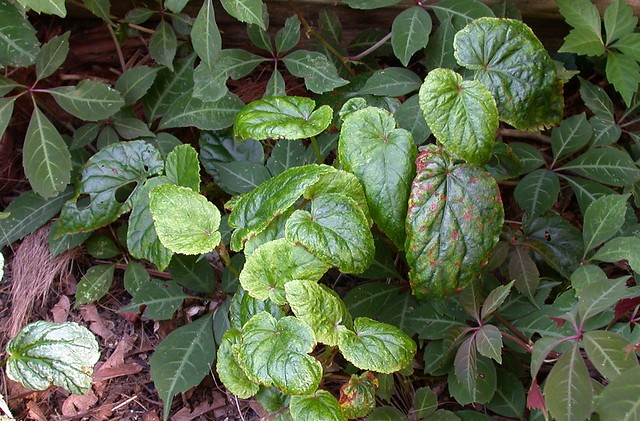
This photo shows a group of begonias from a cross that I thought would be interesting. I made the cross in 2012, and planted the seedlings in the ground last year. Despite our coldest winter in 20 years, all 3 seedlings have come back after protection with only a light mulch.
One parent was Begonia grandis, the hardy begonia. The other was a seed-grown collection of B. longifolia from Taiwan (which would be called B. hayatae by a splitter). I was thrilled when the latter parent bloomed for me because it was a species I had never grown before, and the plants hadn't grown well; they were so weak that I was surprised when one of them bloomed at all. I used it as the pollen parent, and the cross produced several seedlings. The majority were sickly and weak-growing but three of them looked healthy and grew strongly. As with all my hybrid begonias, as soon as they were big enough I planted them out in my garden, to test their performance as bedding plants and also their hardiness.
B. longifolia is a tall-growing Asian species with large, narrow leaves. It never grew well outdoors for me--probably wanting cooler temperatures and higher humidity--and didn't survive its first winter in the ground, which was a mild one. What was I hoping for from this cross? Something like B. longifolia: tall-growing, with large but elegant and narrow foliage, but heat-tolerant; something like an angelwing begonia, but hardy. The hybrids were cute enough as seedlings, but let's face it, most seedlings are cute. As they grew bigger, I began to have misgivings about them. They were just... boring. Plain green leaves, pretty much intermediate between the parents but not distinctive in any way. And to my frustration, they never grew as large as either parent.
Yet here they are, one year later, having survived a cold winter and mocking me and my efforts. To be fair, one reason they look so bad is because they're getting too much sun; it was such a cold winter that the windmill palm that shaded them last year was completely defoliated and is apparently dead. But I went back through last year's photos and even at their shaded best, they never grew strongly and never looked good. They were so pitiful that I'm surprised they survived the winter at all; maybe they did it just to spite me.
What have I learned from this? First, I don't think I'll grow B. longifolia again or use it in any more crosses. It doesn't seem to like my climate, and doesn't seem to bring anything distinctive to the table. I don't have the time, the patience, or the garden space to coddle difficult plants--and frankly, I don't want their genes in my hybrids! Second, you just never know how a cross will turn out. A plant breeder makes a cross with a goal in mind, sometimes vague but sometimes very specific, but once you make that cross, all you can do is grow out the seedlings and see what happens. I guess that's one reason why plant breeding is so fascinating: there are no guarantees, but sometimes, just sometimes, a cross succeeds above and beyond your expectations. But we can learn something from every cross we make, even our failures. In this case it helped show that crosses with B. grandis inherit its hardiness, and that is extremely encouraging as I make more crosses. I hope to showcase some of my more successful hybrids later this year!

Looking forward to seeing what you consider to be more successful crosses. It's cool that you are hybridizing begonias as it's a group of which I'm particularly fond. Sorry to hear that your palm is a goner!
ReplyDeleteI'll write an update about my palms, as well as some other palms around town, in another blog post soon (I still need to visit and get photos of one of the palms I documented last year). As far as the begonias, hardiness aside it would be nice to see a greater variety available; the challenge is dealing with summer heat in my area, which is deadly to most of the tuberous and many other begonias. And most people shy away from the rex hybrids as being demanding and difficult. The semperflorens types are ubiquitous and overused as bedding plants here, but I'm happy to see local gardeners embrace the newer "dragonwing" hybrids, which give a better idea of just how dramatic begonias can be!
DeleteInteresting hear all your observations and findings from crosses John, and now you know more which combinations work better. And how exciting what other possibilities are out there with your future crosses. The thought of having more hardy begonias coming out from your crosses is very exciting!
ReplyDeleteThe possiblities are mind-boggling and despite this particular blog post, I'm having great success with some of my crosses. I can't reveal too much right now as I'm trying to develop some of these as commercial plants, but I hope to have one or two hybrids finally ready for trialing later this year, and several more next year. In fact many of these are showing excellent hardiness; the sticking point is heat tolerance, with many of them looking ragged and tired, or even collapsing, by late July.
DeleteGreat post John! I know I will be rereading this when I find out how many of my hybrids just suck...smile
ReplyDelete